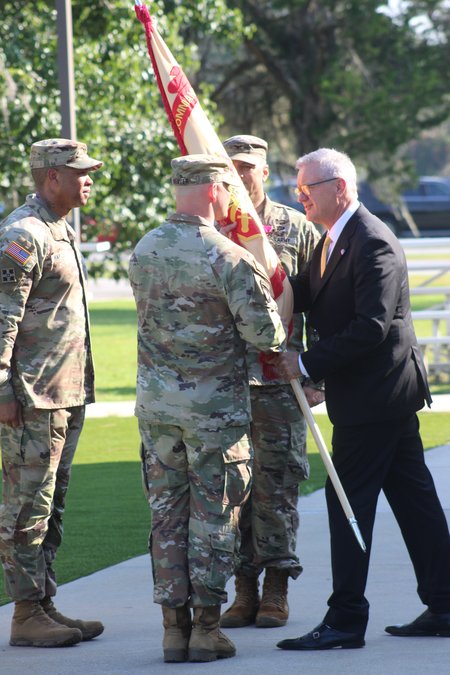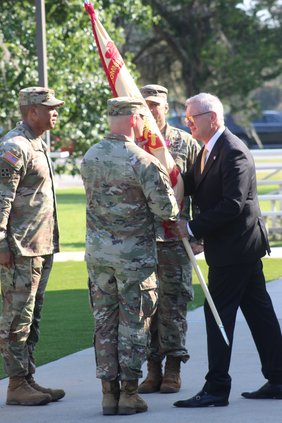As Maj. Gen. Christopher Norrie presented Col. Marc Austin and his wife Katie with accolades upon their departure, he called them “thank yous” from thousands of people.
Col. Austin ceded his post as Fort Stewart/ Hunter Army Airfield garrison commander Tuesday morning to Col. William “Gabe” Weaver, turning over the leadership of the vast post and its tenant organizations.
“I am assuming this command with a deep sense of purpose and gratitude” Col. Weaver said. “There is a strong foundation already in place. I am sure we can continue to excel and make this a place where people want to be.”
Col. Austin, who had been a battalion commander in the 3rd Infantry Division in a previous Fort Stewart posting, will become the director of future warfare division at the Army Futures and Concepts Center.
“This assignment is an honor and very well deserved,” said Pat Appleman, director of readiness for the Installation Management Command.
Appleman said commanding a garrison — and at 287,000 acres, Fort Stewart is the largest in terms of area for the Army’s bases east of the Mississippi River — is a unique assignment. Austin did it will managing critical challenges, Appleman added.
In addition, Fort Stewart was named the second- best Army garrison for 2025 and the tops among garrisons under the Army’s Forces Command.
“You and your team provided exceptional service to soldiers and family members,” he said. “You focused your efforts on the heart and soul of the garrison, always putting soldiers, families, and civilians first.” Maj. Gen. Norrie noted that the garrison has weathered three tropical systems, a snowstorm and multiple deployments, along with the usual hurdles of regular training and quality of life issues for thousands of soldiers and family members.
“This team is healthy. That’s different from saying we’re perfect,” Norrie said. “We’ve got a lot of challenges across the installation but to say the team is healthy means you have a team that you built that trusts each other, that feels valued, that understands its contributions. You have a team that understands the big picture.
“Marc, you’ve done that, amidst all the stress of the last two years. We’ve had three hurricanes. We’ve had issues with housing. We’ve had issues with all the stresses on our civilian workforce. We have had Herculean things that would break lesser teams. This team is stronger today than when you took command.”
Appleman also praised Austin for a series of initiatives, including working with state lawmakers to get the level of tax-free income for veterans raised from $35,000 to $65,000 a year. Austin also brought Second Harvest food distribution to both Fort Stewart and Hunter, serving 1,500 people at Stewart and 300 at Hunter.
Col. Austin counted the number of moves his family has made in his career — 15 to date — and his children have attended five schools in five years. He admitted he had little knowledge of garrison command until he assumed the one at Fort Stewart.
“There is not a second lieutenant who came out of their platoon time and said, ‘I can’t wait to be a garrison commander,’” he joked.
During his two-year tenure as garrison commander, Austin said the question he and his staff asked continuously was how to do things the right way.
“We have to be predictable, we have to be able to communicate, we have to be accountable, we have to integrate with the community,” he said. “What that meant to me is if we apply that same concept to everything we do, we can use the same concepts in how we take care of our soldiers.”
Col. Weaver has spent the past two weeks on Stewart getting to see what his new job entails. He was assistant chief of staff, G4, for the 1st Armored Division at Fort Bliss, Texas, before coming to Fort Stewart.
“It’s a huge mission,” he said. “One of the things we’re proudest of is how engaged we are with the surrounding communities. That is something I want to continue during my command.”
While he hasn’t been stationed at Stewart previously, he acknowledged he’s already heard about the bond between the soldiers and the area.
“Most people who move from here leave a piece of them behind,” he said. “It’s not just the division they want to come back to — it’s the communities and the friends they’ve made. It’s one of those places that builds in a person.”
Col. Weaver also is aware of the investment in the base the civilian workforce has. Many of the civilians have worked for years and in some cases decades and commanders long have praised their efforts in finding ways to do things better or more efficiently.
Col. Austin advised his successor he will learn every day on the job and every day is an adventure — but that the civilians there will take care of him.
“They will drive this installation,” Austin said.
Col. Weaver noted he was “super impressed” with the professionalism and experience of the staff.
“What I do know what I have is a professional and very experienced workforce that has been doing this for years,” he said. “They’ve done it before and they are very experienced. I have no worries that we’re going to be able to handle any situation we run into. No matter if it’s a snowstorm or a hurricane, the professionals here have done it before.”

